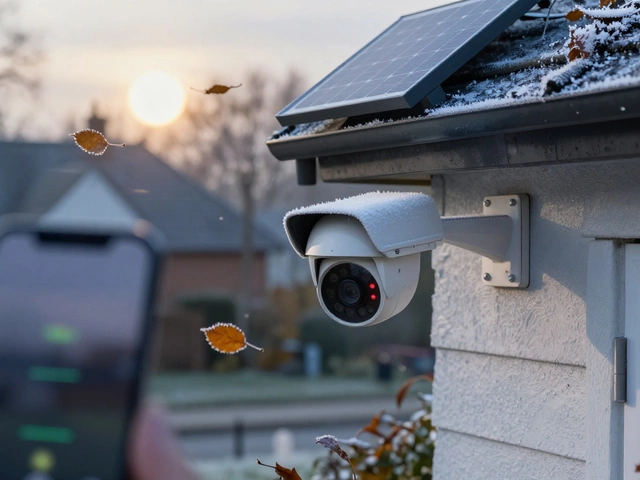Imagine standing at your front door, fumbling to unlock it as a courier waits, glancing at your neighbor’s nosy cat. Now picture checking a video feed on your phone—no matter where you are in Wellington, or even if you’re just upstairs. That instant peace of mind is why smart doorbells are showing up left and right on Kiwi porches and gates. But here’s the brain-tickler: are these clever gadgets totally useless without WiFi? Or is there more going on under their sleek plastic shells? With so much hype around smart tech, a lot of folks are buying devices they think will keep them safer—without really knowing how they work behind the scenes.
How Smart Doorbells Actually Work
Let’s get down to the basics: smart doorbells, like the popular Ring, Google Nest Hello, or Eufy Video Doorbell, have a camera, microphone, speaker, and a handful of sensors inside. When someone presses the button or steps onto your front porch, the doorbell wakes and starts recording. For all that to happen in seconds—and for you to actually get that notification on your phone—they need to send data somewhere. Most smart doorbells send a video feed up to the cloud. That’s not magic; it’s your home WiFi doing the heavy lifting. The doorbell connects to your router just like any laptop or smart TV. It beams video and audio through your internet connection to a server—probably sitting somewhere in Sydney or Singapore—and then back down to your phone, wherever you are.
Without a WiFi link, that back-and-forth doesn’t work. Many brands advertise their systems as ‘wireless,’ but don’t get sucked in—this mostly means they don’t use clunky wires to attach to your house or for video streaming. ‘Wireless’ here isn’t code for ‘also works without internet.’ In fact, no major brand offers a truly smart, cloud-connected doorbell that operates fully without WiFi. That’s because 4G, 5G, and Bluetooth don’t have the power, speed, or range to comfortably move those live video files around. It’s worth noting too: most doorbells run on batteries or low-voltage wiring for power. The wireless piece means video and notifications travel over WiFi, but not the electricity itself.
A few models let you store video offline on an SD card (usually inside the doorbell itself or in a local base station wired to your router). This way, if your internet craps out, you’ll still have footage—but you won’t get instant alerts. You’ll have to pull the card and check the video the old-fashioned way. Some higher-end brands, like Eufy, offer this as a feature, but it’s the exception, not the rule. For most setups, no WiFi means no notifications, no two-way talk, no ‘ding’ on your mobile when someone’s at the door. The live features people love most about smart doorbells? They’re gone if your WiFi goes down.
Can Smart Doorbells Work Without WiFi?
Here’s the real talk: smart doorbells just aren’t that smart without a network. Let’s break this down. If you lose WiFi for a few minutes—maybe someone trips over your router cable, or a storm knocks things offline—some doorbells will keep recording locally for a while. Usually, only the motion sensor and the actual doorbell chime still work. In Wellington, we have the odd day when a southerly roars in and power flickers, so local storage is handy for catching opportunistic visitors (or the odd prankster).
But let’s not sugarcoat things. Once your WiFi goes down, you stop receiving push notifications. You lose live streaming. You can’t yell ‘Hey, leave the parcel behind the shed!’ to a delivery driver. If you want smart features—remote access, instant alerts, the ability to see and speak to visitors on your mobile—you’re out of luck until the WiFi is back up. There’s no secret hack or magic workaround. Even doorbells that support SD cards only let you review footage after the fact. A handful of devices let you connect to a local base station within the house, so even if the cloud is unreachable, you have a record. But this is rare, and most people set and forget their doorbells, never checking until they actually need proof of a visitor.
If you skip WiFi completely, you’re stuck with the basic ‘push button, ring chime inside’ setup—exactly like an old-school wired doorbell, with none of the features that make smart doorbells cool to begin with. That’s not a real upgrade if you ask me. So if you’re weighing up the purchase, think hard about your home’s WiFi strength. Put the router somewhere central, avoid thick brick walls, and maybe invest in a range extender if your signal struggles to reach the front door.

Alternatives for Homes With Poor WiFi
Maybe you live in a sprawling villa in Karori or a tricky, concrete-heavy flat where WiFi barely reaches the front gate. Good news: there are workarounds, but each comes with trade-offs. For most people, throwing in a WiFi mesh system is the quickest fix—these spread your signal around the house using satellite units, giving your smart devices better coverage. Mesh kits are easy enough to set up. Plug in a base unit, scatter some satellites somewhere a bit out of the way—but still clear of metal shoe racks or giant pots. Many systems have phone apps that help you find the best spots. They’re not cheap, but a few hundred bucks on a mesh system saves a heap of stress and stops your video feed from pausing at the worst moment.
If fiber or fast WiFi just isn’t an option, consider doorbells that support wired Ethernet. Some rare models (mostly pro-level systems) let you run a cable from your router straight to the device. This is an ugly solution, but rock-solid—no dropping out, barely any lag, and not affected by thick walls. For those who can’t drill or cable, 4G/5G-enabled smart doorbells exist, but they’re rare and expensive. These use a SIM card (the kind you’d put in a phone) and send video over the mobile network. In city areas with great reception (hello, downtown Wellington), this can work well, but it eats mobile data and chews through your wallet, both for the upfront device and ongoing plans. Plus, most models aren’t designed for regular home users, but project sites or remote holiday homes. If you just need eyes on a gate in a rural area, this may be worth a look.
Still, the classic low-tech alternative might surprise you. Conventional wireless doorbells (not ‘smart’ ones)—the kind with a button outside and a plug-in chime inside—work without WiFi at all. They use simple radio frequencies, don’t connect to your phone, but do the core job if your number one priority is just knowing when someone’s knocking rather than seeing their face or having a running archive of every visitor. Some people even pair a basic camera (like a wired CCTV or trail cam) on the porch with a traditional doorbell, then check the footage later—maybe not glamorous, but it’s one way to keep tabs without needing strong WiFi.
Tips for Getting the Most From Your Smart Doorbell
If you’re set on getting a smart doorbell—and you should if you want that extra security—there are a few moves you can make to dodge common headaches. First, don’t underestimate the power of a good WiFi connection. Always do a signal check near your door before installing. Plenty of brands offer test modes and phone apps that measure signal strength. Look for numbers above -60 dBm for smooth, reliable video and fast alerts.
- Regularly check your doorbell software and app for updates. Hackers love old software. Most problems around lost video or buggy notifications come down to a neglected update or two.
- Be smart about your placement. Metal doors, brick cladding, or even ceramic tiles near the unit can block signals. Try to mount the doorbell at least a meter above ground, giving it a clear view and an unobstructed path to your router.
- If possible, get a doorbell that supports local storage, like a microSD card or indoor base unit. You won’t always have time to fight your ISP when the service goes down, especially in the middle of the night.
- Set a strong, unique password for your doorbell account. Don’t use the default login, and don’t share your account around your flat just for convenience.
- If your home network is full of other smart devices—TVs, speakers, lights, and so on—make sure your router can handle dozens of ‘talking’ gadgets. Cheaper routers can drop connections or cause lag. Consider an upgrade or, at least, a WiFi extender.
- For renters or folks who move often, look for battery-powered models. They’re easier to install, take down, and move to a new place. Just remember to charge them—set reminders in your phone and swap the battery every few months.
If you’re worried about reliability, keep a backup plan—either a simple traditional doorbell so visitors can still ring if your WiFi is off, or a rule with couriers about safe places to leave parcels (a common trick in NZ neighborhoods). Don’t bet your whole sense of security on one bit of tech, no matter how clever the advertisements sound.
At the guts of it, smart doorbells really do need WiFi to let you see, talk, and get instant updates, and that’s the reason why a dodgy signal kills so much of their charm. A little prep—testing your network, picking the right device, and having a fallback for when things go sideways—means fewer headaches, more peace of mind, and all the home security benefits these clever gadgets can offer. So next time you eye up a new video doorbell, think about how good your home WiFi is right at the front door. The smartest tech only shines if your connection’s up to the job.






